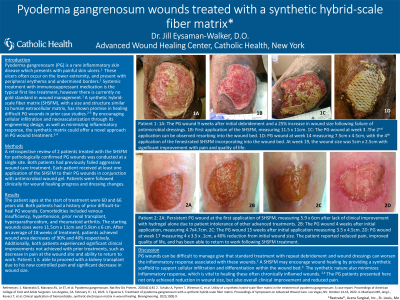Case Series/Study
(CS-056) Pyoderma Gangrenosum Wounds Treated with a Synthetic Hybrid-Scale Fiber Matrix*

Pyoderma gangrenosum (PG) is a rare inflammatory skin disease which presents with painful skin ulcers.1 These ulcers often occur on the lower extremity, and present with peripheral erythema and undermined borders.1 Systemic treatment with immunosuppressant medication is the typical first line treatment, however there is currently no gold standard in wound management.1 A synthetic hybrid-scale fiber matrix, with a size and structure similar to human extracellular matrix, has shown promise in healing difficult PG wounds in prior case studies.2-3 By encouraging cellular infiltration and neovascularization through its engineered design, as well as minimizing inflammatory response, the synthetic matrix could offer a novel approach in PG wound treatment.2-4
Methods:
A retrospective review of 2 patients treated with the synthetic hybrid-scale fiber matrix for pathologically confirmed PG wounds was conducted at a single site. Both patients had previously failed aggressive wound care treatment. Each patient received one application of the synthetic hybrid-scale fiber matrix to their PG wounds in conjunction with antimicrobial wound gel. Patients were followed clinically for wound healing progress and dressing changes.
Results:
The patient ages at the start of treatment were 60 and 64 years old. Both patients had a history of prior difficult to heal PG wounds. Co morbidities included venous insufficiency, hypertension, prior renal transplant, hyperparathyroidism, and rheumatoid arthritis. The starting wound sizes were 5.9 cm x 6 cm and 11.5 cm x 11 cm, and patients continue to undergo treatment with the synthetic hybrid-scale fiber matrix.
Discussion:
PG wounds can be difficult to manage given that standard treatment with repeat debridement and wound dressings can worsen the inflammatory response associated with these wounds.2 A synthetic hybrid-scale fiber matrix may encourage wound healing in these patients by proving a synthetic scaffold to support cellular infiltration and differentiation within the wound bed.4 The synthetic nature also minimizes inflammatory response, which is vital to healing these often chronically inflamed wounds.2,4
Trademarked Items: *Restrata® Acera Surgical, Inc., St. Louis, Missouri
References:
References:
1. Maverakis E, Marzano AV, Le ST, et al. Pyoderma gangrenosum. Nat Rev Dis Primers. 2020;6(1):81
2. Schultz A, Pynter T, Wireman G, et al. Utility of a synthetic hybrid-scale fiber matrix in the treatment of pyoderma gangrenosum: A case report. Proceedings of American College of Foot and Ankle Surgeons. Los Angeles, CA. February 9 – 12, 2023.
3. Figueroa S. Treatment of pyoderma gangrenosum with a synthetic hybrid-scale fiber matrix. Proceedings of Symposium on Advanced Wound Care. Las Vegas, NV. October 14-16, 2022.
4. MacEwan MR, Jeng L, Kovacs T, et al. Clinical application of bioresorbable, synthetic electrospun matrix in wound healing. Bioengineering. 2023;10(9):9.

.png)